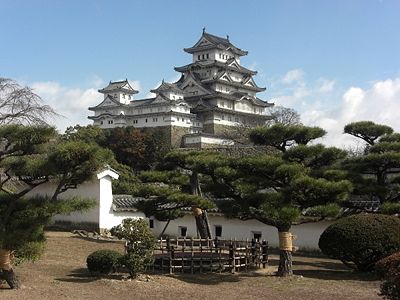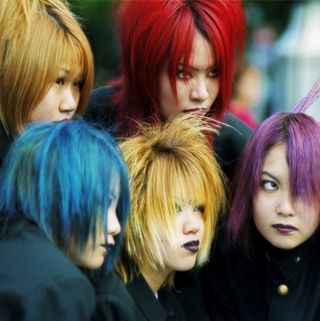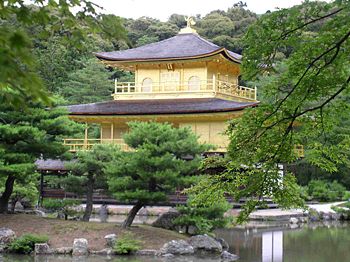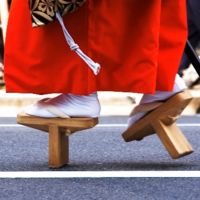Culture of Japan

Himeji Castle is a UNESCO World Heritage site; its defences and gardens showcase two sides of Japan's history and culture.
The culture of Japan has evolved greatly over the years, from the country's original Jomon culture to contemporary times, which combines influences from Asia and the West. After several waves of immigration from the continent and nearby Pacific islands (see History of Japan), followed by a heavy importation of Chinese culture, the inhabitants of Japan experienced a long period of relative isolation from the outside world under the Tokugawa shogunate, until the arrival of the 'Black Ships' and the Meiji era. As a result, a culture distinctively different from other Asian cultures developed, and echoes of this persist in Japan today. Template:TOC-right
Japanese language
The Japanese language has always played a significant role in Japanese culture. Spoken mainly in Japan and by some Japanese communities around the world, it is an agglutinative language - grammatical units link together in long 'strings' to make words[1] - and its 'sounds' consist mainly of consonant-vowel units that cannot be split up, such as bu, ni and ka (see Japanese phonology). The language also makes use of pitch rather than stress to distinguish many words.
Early Japanese is known largely on the basis of its state in the eighth century, when the three major works of Old Japanese were compiled. The earliest attestation of Japanese is in a Chinese document from 252 AD.
The Japanese language is written with a combination of three different scripts. Chinese characters (漢字 kanji) are used for the most meaningful words such as most nouns and verbs; these take some time to learn. Two further scripts, hiragana (ひらがな) and katakana (カタカナ) write moras, equivalent to but not the same as syllables, and to a degree can indicate pronunciation. The Latin alphabet, rōmaji (ローマ字), is also often used in modern Japanese. These are used for different purposes (see Japanese language - Writing system). The Hindu-Arabic numerals are generally used for numbers, but traditional Sino-Japanese numerals are also commonplace.

Photo © by Sonny Santos, used by permission.
Visual arts
Painting, calligraphy and woodblock prints
- See also: Japanese painting, Japanese calligraphy, and Ukiyoe
Some of the most traditional Japanese art involves representations in paint, woodblock prints and careful rendering of Japanese text. Painting, such as sumie (墨絵, 'wash painting'), has been an art in Japan for a very long time: the brush is a traditional writing tool, and the extension of that to its use as an artist's tool was probably natural, hence calligraphy; as in other East Asian countries, the rendering of text itself is seen as a traditional art form as well as a means of conveying information. The art can consist of phrases, poems, stories, or even single characters. The style and format of the writing can mimic the subject matter, even to the point of texture and stroke speed. The creation of the calligraphy is considered as much an art as the pictures themselves, and it can take over one hundred acts of mimicry to produce the desired effect of a single character.
Ukiyoe (浮世絵, literally 'pictures of the floating world') is a genre of woodblock prints that exemplifies the characteristics of pre-Meiji Japanese art. Because these prints could be mass-produced, they were available to a wide cross-section of the Japanese populace — those not wealthy enough to afford original paintings — during their heyday, from the seventeenth to the twentieth century. The widespread popularity of ukiyoe prints lead to their recognition as a very Japanese art form, which in turn has led to significant modern mimicry of ukiyoe in advertisements, posters, and other art including manga comics.
Sculpture and flower arranging
- See also: Japanese sculpture and Ikebana
sculpture and flower arranging (活花, ikebana). Wood, often lacquered, gilded, or brightly painted, is the most common traditional sculpting material, but bronze and other metals are also important. Ikebana is more widely known outside Japan for its focus on harmony, colour use, rhythm, and elegantly simple design. It is an art centred greatly on expressing the seasons, and is meant to act as a symbol to something greater than the flower itself.
Performing arts
Mention Kabuki, Noh, Takurazuka, and Bunraku.
Architecture
Japanese architecture has as long a history as any other aspect of Japanese culture. Originally heavily influenced by Chinese architecture, it also develops many differences and aspects which are indigenous to Japan. Examples of traditional architecture are seen at Temples, Shinto shrines and castles in Kyoto and Nara. Some of these buildings are usually constructed with traditional gardens, which are influenced from Zen ideas.
Some modern architects, such as Yoshio Taniguchi and Tadao Ando are known for their amalgamation of two different ideas, Japanese traditional architecture and Western one.
Clothing
- See also: Geta
The Japanese word kimono (着物) means 'something one wears'; it is a traditional garment of Japan. Originally, the word kimono was used for all types of clothing, but eventually, it came to refer specifically to the full-length garment also known as the nagagi, meaning 'long-wear', that is still worn today on special occasions by women, men, and children. It is often known as wafuku, which means 'Japanese clothes'. Kimono come in a variety of colours, styles, and sizes. Men mainly wear darker or more muted colours, while women tend to wear brighter colours and pastels, and often with complicated abstract or floral patterns. The summer kimono, which are lighter, are called yukata. Formal kimono are typically worn in several layers, with number of layers, visibility of layers, sleeve length, and choice of pattern dictated by social status and the occasion for which the kimono is worn.
Cuisine
Through a long culinary past, the Japanese have developed a sophisticated and refined cuisine highly sensitive to the change of seasons. Modern Japanese enjoy a variety of traditional Japanese food, including the staples of rice and miso soup, as well as many seafood dishes (sushi and sashimi for instance), and a multitude of foreign dishes. One can easily find Chinese, Korean, and Thai dishes as well as non-regional American, French, and Italian foods. Japanese cuisine is a product of its environment and people. The ease of acquiring fresh ingredients led to sushi, high temperature and humidity led to varieties of pickled and fermented food like natto and soy sauce, and adaptation of foreign cuisines led to ramen, which originated in China, and other forms of noodles such as soba.
Sport
The most popular sport in Japan is baseball; annual attendance is around 200 million per year. Though football has become more popular in recent years, it remains that more Japanese bought tickets for baseball games than to watch World Cup matches when Japan staged the event in 2002.[2]
Many other foreign-rooted sports are popular in Japan, such as table tennis, tennis, volleyball, basketball, golf, and rugby.
Martial arts
Martial arts are popular in Japan, especially Japanese ones; they may combine elements of competitive sport with self-defence, fitness training and spectacle, and many Japanese train in, compete in and watch these along with combat sports. The best-known Japanese martial arts sport outside the country is sumō (相撲) wrestling, which includes elements of the local Shintō (神道) religion. Other Japanese martial arts include jūdō (柔道, 'gentle way'), karate (空手, 'empty hand'), aikidō (合気道, 'way of harmony') and kendō (剣道, 'way of the sword'). Judo is perhaps the most popular, as high schools and universities have teams for interscholastic competition.
Some martial arts, such as aikido, iaidō (居合道, 'way of drawing the sword') and kenjutsu (剣術, 'fencing') are practiced almost solely for non-competitive reasons. Some martial arts also play a spiritual or religious role in Japan. Kyūdō (弓道, 'way of the bow'), or Japanese archery, has become related to and involved in the study of Zen Buddhism. Aikido is considered in Japan to be a religion and philosophy as well as a martial art.
Mixed martial arts and similar combat sports have also become popular in Japan in the past few decades, with the most well-known example being the mixed martial arts organisation known as the Pride Fighting Championships. Shooto (修斗 shūto 'learn combat') as a sport has been popular, with techniques derived from shoot wrestling. Professional wrestling, or puroresu (プロレス), is also popular, although this is technically not a combat sport as such events are typically 'works' (staged) and not true competitions.
Martial arts in popular culture
Japanese entertainment has many references to martial arts. Traditional Japanese theatre and literature include stories like The 47 Ronin and works such as The Book of Five Rings and Hagakure (葉隱, 'In the Shadow of Leaves', also known as The Book of the Samurai). Japanese films often have martial artists as characters or martial arts as the theme, such as in samurai films like The Seven Samurai. In Japanese popular culture, anime and manga often heavily feature characters trained in (usually highly stylised) martial arts, as in Dragon Ball Z, Samurai Champloo, and Naruto.
Popular culture

Photo © by Sonny Santos, used by permission.
Japanese popular culture not only reflects the attitudes and concerns of the present but also provides a link to the past. Popular films, television programmes, comics, and music all developed from older artistic and literary traditions, and many of their themes and styles of presentation can be traced to traditional art forms. Contemporary forms of pop-culture, much like the traditional forms, provide not only entertainment but also an escape for contemporary Japanese from the problems of an industrial world.
Although Japan is often thought of as a hard-working society with little time for pleasure, the Japanese seek entertainment wherever they can. It is common to see Japanese commuters riding the train to work, enjoying their favourite manga(漫画 'comic') or listening through earphones to the latest music on portable players. There is a wide range of music, films, and the products of a huge comic book industry, among other forms of entertainment. Game centres, bowling alleys, and karaoke (カラオケ, 'empty orchestra') are popular for young people, while older people may play shogi or go in specialised parlours.
Leisure time
When asked how they spent their leisure time, 80% of a sample of men and women surveyed by the government in 1986 said they averaged about two and a half hours per weekday watching television, listening to the radio, and reading newspapers or magazines. Some 16% spent an average of two and a quarter hours a day engaged in hobbies. Others spent leisure time participating in sport, socialising, and personal study. Teenagers and retired people reported more time spent on all of these activities than did other groups.
Footnotes
- ↑ Example: tabetakunakatta - tabe 'eat', -ta- 'want', -kuna- 'negative', -katta 'past' - i.e. 'did not want to eat'.
- ↑ Japan Times: 'It may be the world's most popular sport, but not here in Japan'. 5th July 2002.

